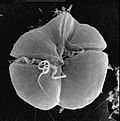Karenia mikimotoi is a dinoflagellate species from the genus Karenia. Its first appearance was in Japan in 1935 and since then, it has appeared in other...
6 KB (708 words) - 01:08, 13 March 2024
brevisulcata Karenia concordia Karenia cristata Karenia digitata Karenia longicanalis Karenia mikimotoi Karenia papilionacea Karenia selliformis Karenia umbella...
12 KB (1,488 words) - 01:18, 13 March 2024
typical golden brown color. However, the dinoflagellates Karenia brevis, Karenia mikimotoi, and Karlodinium micrum have acquired other pigments through...
96 KB (10,320 words) - 21:44, 13 August 2024
was caused by a particular, toxic species: Karenia mikimotoi. This is the stuff of science fiction. Karenia thrives in temperatures between 20 and 24 °C...
28 KB (3,607 words) - 12:36, 18 July 2024
analyses of rDNA indicates Karenia papilionacea, together with K. selliformis and K. bicuneiformis, is closely related to K. mikimotoi and K. brevis. Haywood...
3 KB (364 words) - 01:22, 13 March 2024
analyses of rDNA indicates Karenia selliformis, together with K. papilionacea and K. bicuneiformis, is closely related to K. mikimotoi and K. brevis. Haywood...
6 KB (574 words) - 01:12, 13 March 2024
other phytoplankton species, such as Prorocentrum donghaiense and Karenia mikimotoi. K. veneficum often proliferates into dense blooms following the decline...
5 KB (542 words) - 01:17, 13 March 2024
analyses of rDNA indicates Karenia bicuneiformis, together with K. selliformis and K. papilionacea, is closely related to K. mikimotoi and K. brevis. Haywood...
4 KB (401 words) - 01:20, 13 March 2024
survey of the sterol composition of the marine dinoflagellates Karenia brevis, Karenia mikimotoi, and Karlodinium micrum: distribution of sterols within other...
33 KB (3,462 words) - 06:14, 31 July 2024
was caused by a particular, toxic species: Karenia mikimotoi. This is the stuff of science fiction. Karenia thrives in temperatures between 20 and 24 °C...
22 KB (2,679 words) - 08:52, 6 December 2023





